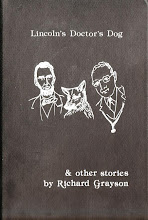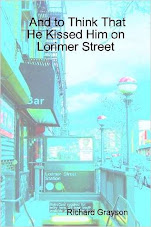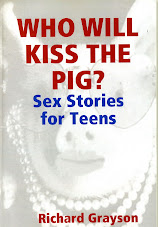
Roll Call, the newspaper of Capitol Hill, today (December 6, 2005) has an article about Richard Grayson's WRITE-IN: Diary of a Congressional Candidate in Florida's Fourth Congressional District:
Life on the Campaign Trail
By Elizabeth Brotherton
Roll Call Staff
Tuesday, December 6, 2005
Remember the heated battle over Florida’s 4th Congressional district last summer?
You don’t?
Well, that’s probably because the race didn’t attract too much attention. But there was one.
It pitted incumbent Rep. Ander Crenshaw (R-Fla.) against writer Richard Grayson, a Democratic write-in candidate running on a platform in support of gay marriage, abortion rights, universal health care and immediate withdrawal from Iraq.
Keep in mind, this race took place in one of Florida’s most conservative districts.
So why did Grayson even bother?
“Voters are essentially disenfranchised,” said Grayson, now 54. “It’s frustrating, that yeah, we have a democracy, and yet most of the Florida Representatives were essentially unopposed. From both parties.”
Annoyed, Grayson decided to hit the campaign trail. He documented his journey in a series of diary entries published on McSweeneys.net, which have been put into a book titled “Diary of a Congressional Candidate in Florida’s Fourth Congressional District.”
Grayson was no rookie, either. He ran for president in 1984 and twice as a write-in candidate against Republican House Members, for similar reasons as in his race against Crenshaw.
“It was really a fun thing to do,” Grayson said of his latest campaign. “And I think having McSweeney’s publish the diary as I was writing it, with a couple weeks time lag, got attention.”

Grayson’s journey begins on May 7, 2004, the day the Florida Division of Elections posted his name as an official candidate in the race. But because he couldn’t afford the $9,000 filing fee, Grayson was listed as a write-in candidate. (Grayson notes in the book that in March 2004, Crenshaw had a war chest of $612,691.)
Throughout the diary, Grayson documents life on the campaign trail. Or rather, trying to get to there.
Grayson ran for the 4th district seat, a long, narrow stretch of land across the Northeastern part of the state that encompasses parts of Tallahassee and Jacksonville.
Even though he lived in South Florida.
See, in his home 22nd district, there was already a race under way between Republican incumbent Rep. Clay Shaw and Democrat Jim Stork. Grayson’s goal in running was to make a point, even if he didn’t stand much of a chance at getting elected.
“Every Congressional race in this country I would like to see have at least two candidates,” he said.
Grayson picked the 4th district because he noticed Congressional representation for Jacksonville was safely divided between the two parties, with Rep. Corrine Brown (D) holding the other seat.
“Basically, I had the feeling the two major parties pretty much like it the way it is,” he said. “They like the fact that the city of Jacksonville has one Democratic seat, one Republican seat.”
But since Grayson worked a normal day job from 8:30 a.m. to 5 p.m. Monday through Friday, he found it difficult to get to the Jacksonville area. He didn’t even set foot in the 4th district until Oct. 2 to do a television spot at a Jacksonville CBS affiliate.
So many of Grayson’s campaign efforts consisted of filling out surveys from various interest groups, ranging from the National Taxpayers Union to the Vision Council of America, and hoping somebody somewhere might hear of his candidacy and want to vote for him.
Then, he had to deal with people wanting to sell him everything from software programs to potholders.
“They don’t realize I’m running this campaign out of my studio apartment,” Grayson said. “What it tells me is that campaigns are very big business in this country. It’s sort of this whole class of people who make their money out of the election industry.”
As the months wore on, Grayson started to hit the trail a bit more, and it began to pay off. His proudest moment came in October 2004, when he was endorsed by the National Organization for Women Political Action Committee.
“I was actually touched by that, because it was probably the most serious organization that endorsed me,” Grayson said.
In the end, Grayson received 1,170 votes, which amounts to 0.5 percent of the total count. Crenshaw got the other 99.5 percent with 256,157 votes.
“I was sort of surprised. I got more votes than I expected,” Grayson said.
Grayson has not ruled out running again for office, although he admits his strong liberal views wouldn’t likely get him elected (“I think I’d have to find a new country,” he said).
And he got to do something in 2004 even many Members don’t get to do.
“I never had to pander for any votes, because frankly, I didn’t care if anybody voted for me,” he said. “I imagine some of the Members of Congress must envy that sort of thing.”
The “Diary of a Congressional Candidate” is available to purchase online at http://www.lulu.com/content/172015 or by visiting Grayson’s Web site at www.richardgrayson.com. The book costs $9.38, or $2.37 to download.





































